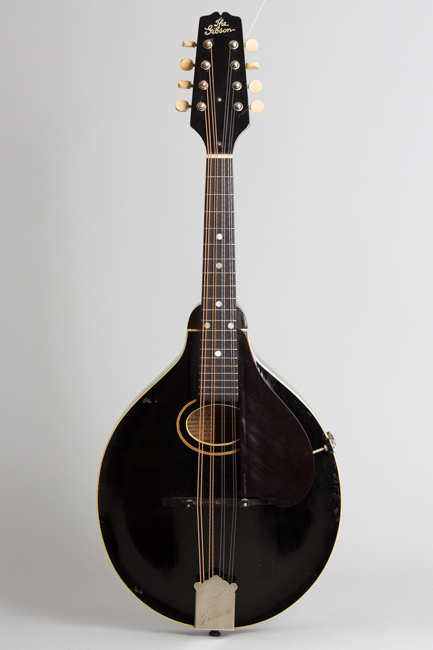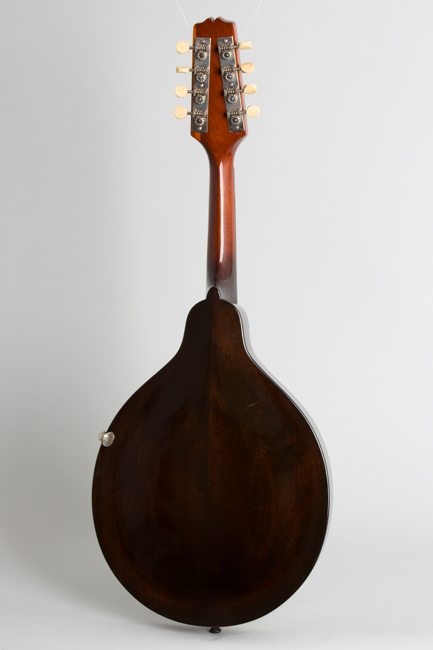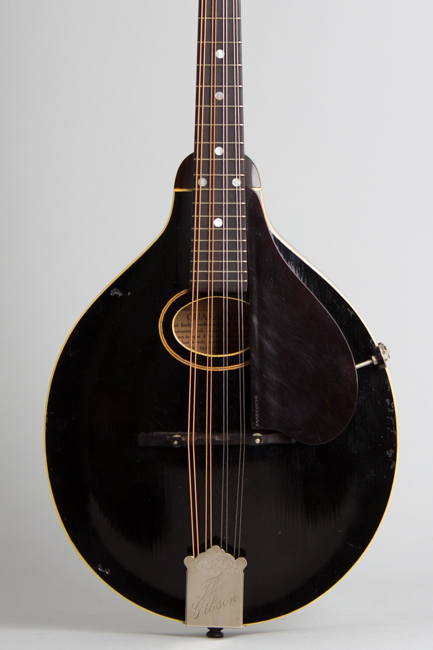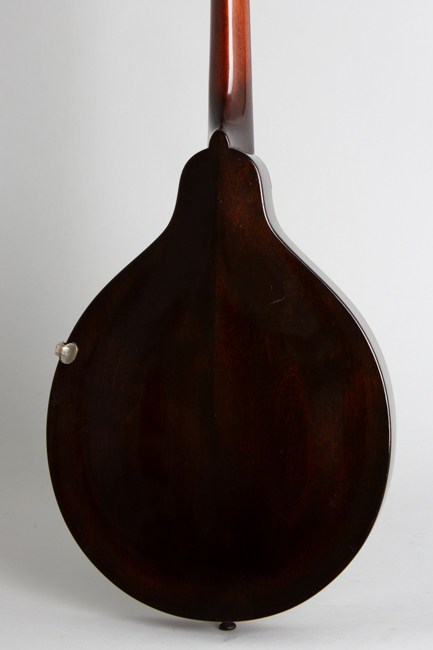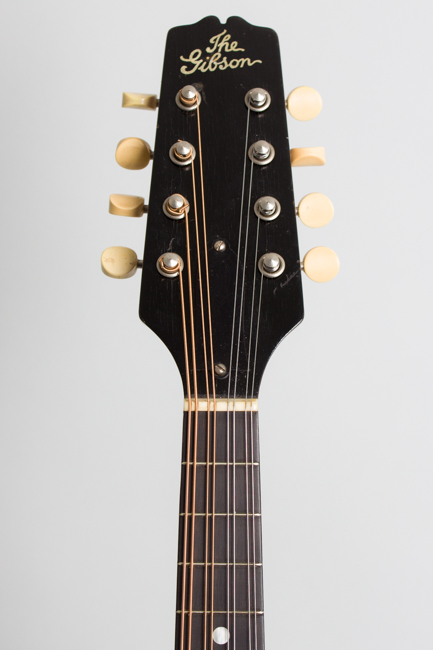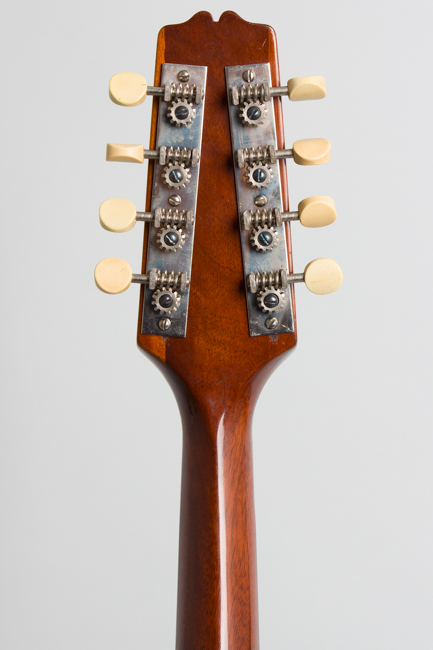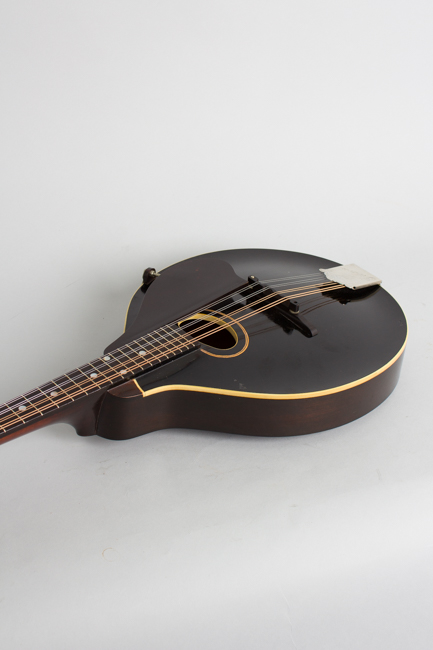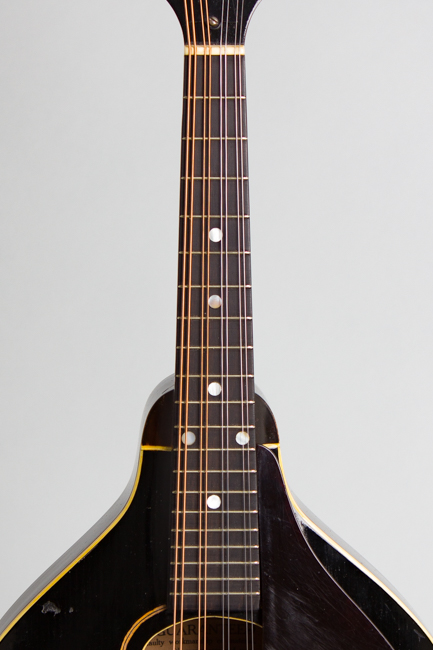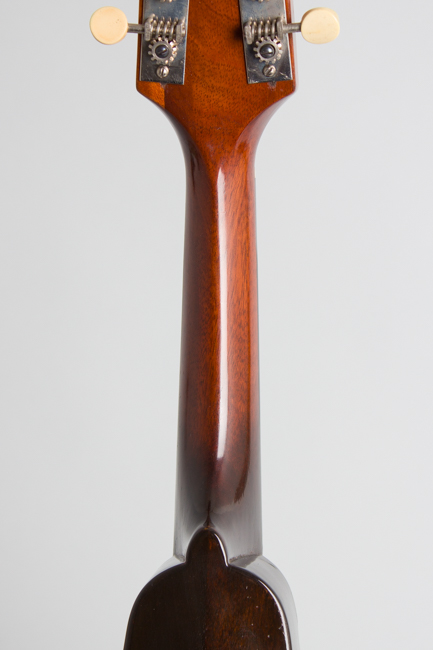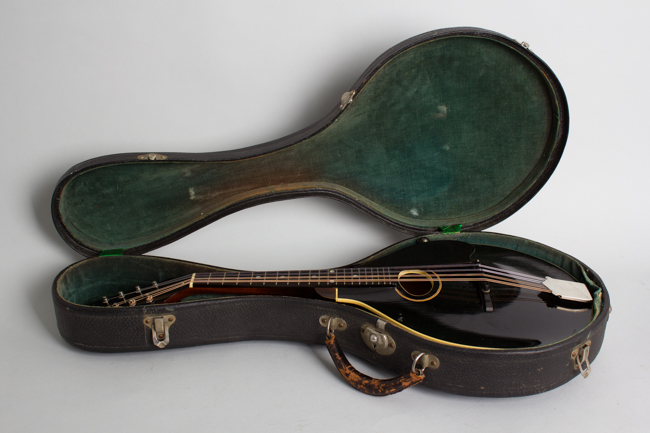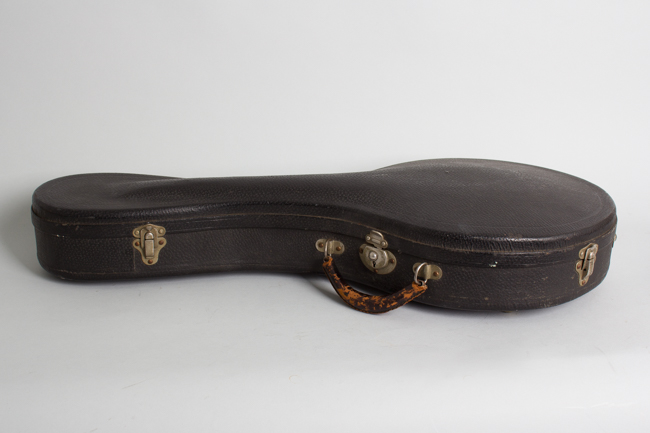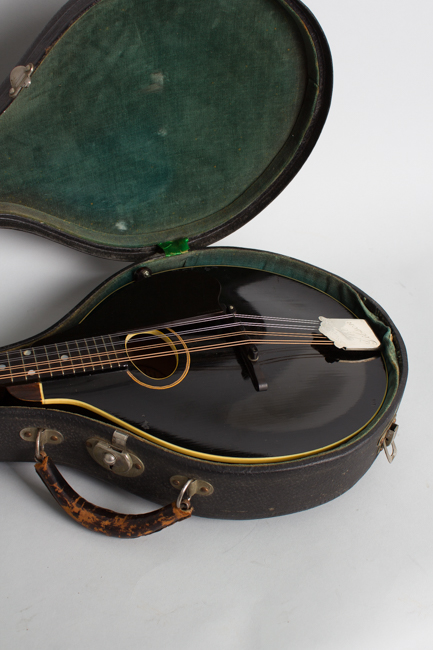Gibson Style A Snakehead Carved Top Mandolin (1925)
Gibson Style A Snakehead Model Carved Top Mandolin (1925), made in Kalamazoo, Michigan, serial # 78022, black top, dark stained back and sides finish, birch back and sides, spruce top, mahogany neck with ebony fingerboard, original black hard shell case.
This is a great-playing and sounding, nicely preserved Style A mandolin from early 1925, just at the end of the "Loar era" at Gibson. These "Snakeheads" are generally considered the best-sounding roundhole A style mandolins ever made, and this one certainly bears it out. This is a fine example of Gibson's craftsmanship at the apex of the mandolin era, just before the company's focus shifted to banjos and then guitars.
These "Snakehead" instruments are named for their Loar-designed peghead that angles inward towards the tip, a very logical design feature inexplicably abandoned by Gibson a couple of years after he left the company. They are revered for their unmatched tone and projection and have other advanced features of the era including the adjustable truss rod neck, raised adjustable bridge and very slim neck profile. The top on this A bears a striking black lacquer finish, bound in white celluloid with a thin double inlaid wood soundhole ring. The tailpiece has the engraved "The Gibson" cover plate and the tuners are strips with plain ends. The stenciled silver script "The Gibson" logo on the headstock is specific to this period.
Lloyd Loar's tenure as acoustic engineer at Gibson has become so mythical that sometimes separating fact from fiction is difficult. Certainly the mandolin family instruments made during the period of his employment are the most perfectly realized in Gibson's history, and have become the template for most similar instruments since. Mandolins in particular of the "Loar era" show the influence of a master player on both design and execution, although other Gibson employees (especially Thaddeus McHugh and Lewis A. Williams) actually engineered many of the technical improvements of the early 1920's. Loar was primarily concerned with 'voicing' the instruments properly; the Master Model Style 5 line was his greatest contribution with their violin-style F-hole tops, but all Gibson mandolin family instruments were refined at the same time. Even this basic "A" model has noticeable sonic and playing improvements benefitting from "Master Loar's" input that are still evident today, nearly 100 years on. These distinctive "Loar era" A mandolins have become ever more sought-after by discerning players.
Overall length is 25 3/4 in. (65.4 cm.), 10 in. (25.4 cm.) wide, and 1 7/8 in. (4.8 cm.) in depth, measured at side of rim. Scale length is 14 in. (356 mm.). Width of nut is 1 1/16 in. (27 mm.).
This is a very good playing and sounding "snakehead", showing not much wear for 99 years on earth wear and remaining pretty much all original. The finish appears unaltered original and mostly quite clean with no added lacquer or other overspray. Overall it shows only some small dings, scrapes and dents overall with some random larger chips to the top mostly along the edge. The back of the neck is very clean.
All seams are solid and there are no visible repairs to the wood. All hardware including the tuners, tailpiece and cover, pickguard and adjustable bridge appear original. The tuners have been reversed from their original "upside down" mounting leaving a small filled hole in the headstock rear at the base of each strip. There is some mostly superficial scuffing to the pickguard. The original frets have been crowned down just a bit and this splendid mandolin plays great, sounds spectacular, and still resides in its clean original HSC. Overall Excellent Condition.
This is a great-playing and sounding, nicely preserved Style A mandolin from early 1925, just at the end of the "Loar era" at Gibson. These "Snakeheads" are generally considered the best-sounding roundhole A style mandolins ever made, and this one certainly bears it out. This is a fine example of Gibson's craftsmanship at the apex of the mandolin era, just before the company's focus shifted to banjos and then guitars.
These "Snakehead" instruments are named for their Loar-designed peghead that angles inward towards the tip, a very logical design feature inexplicably abandoned by Gibson a couple of years after he left the company. They are revered for their unmatched tone and projection and have other advanced features of the era including the adjustable truss rod neck, raised adjustable bridge and very slim neck profile. The top on this A bears a striking black lacquer finish, bound in white celluloid with a thin double inlaid wood soundhole ring. The tailpiece has the engraved "The Gibson" cover plate and the tuners are strips with plain ends. The stenciled silver script "The Gibson" logo on the headstock is specific to this period.
Lloyd Loar's tenure as acoustic engineer at Gibson has become so mythical that sometimes separating fact from fiction is difficult. Certainly the mandolin family instruments made during the period of his employment are the most perfectly realized in Gibson's history, and have become the template for most similar instruments since. Mandolins in particular of the "Loar era" show the influence of a master player on both design and execution, although other Gibson employees (especially Thaddeus McHugh and Lewis A. Williams) actually engineered many of the technical improvements of the early 1920's. Loar was primarily concerned with 'voicing' the instruments properly; the Master Model Style 5 line was his greatest contribution with their violin-style F-hole tops, but all Gibson mandolin family instruments were refined at the same time. Even this basic "A" model has noticeable sonic and playing improvements benefitting from "Master Loar's" input that are still evident today, nearly 100 years on. These distinctive "Loar era" A mandolins have become ever more sought-after by discerning players.
Overall length is 25 3/4 in. (65.4 cm.), 10 in. (25.4 cm.) wide, and 1 7/8 in. (4.8 cm.) in depth, measured at side of rim. Scale length is 14 in. (356 mm.). Width of nut is 1 1/16 in. (27 mm.).
This is a very good playing and sounding "snakehead", showing not much wear for 99 years on earth wear and remaining pretty much all original. The finish appears unaltered original and mostly quite clean with no added lacquer or other overspray. Overall it shows only some small dings, scrapes and dents overall with some random larger chips to the top mostly along the edge. The back of the neck is very clean.
All seams are solid and there are no visible repairs to the wood. All hardware including the tuners, tailpiece and cover, pickguard and adjustable bridge appear original. The tuners have been reversed from their original "upside down" mounting leaving a small filled hole in the headstock rear at the base of each strip. There is some mostly superficial scuffing to the pickguard. The original frets have been crowned down just a bit and this splendid mandolin plays great, sounds spectacular, and still resides in its clean original HSC. Overall Excellent Condition.
